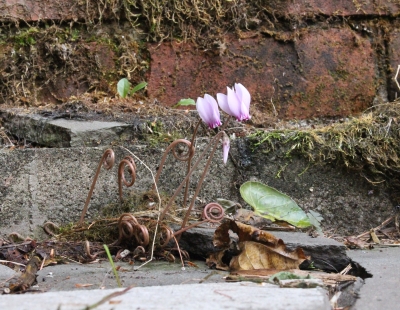I Find Common Ground, and More, in Maine
/3 Comments/in Design, Flowers, Fruit, Gardening, Uncategorized/by Lee ReichMy Favorite Country Faire
Two dogs, one cat, six ducks, and one chicken are trusted to the care of friends; sourdough starter is re-fed and chilled; plants are on their own. It’s hard to leave the farmden. But this trip — to Maine — is well worth it.
Walking through the entrance gate to the Common Ground Fair in Unity, Maine, my senses are overloaded with color and fragrance. Along either side of the entrance path are boxes piled high with bright orange carrots, spilling over with the blue green leaves of kale, or packed full with yellow or red beets. Also flowers, herbs, and cheeses. Pervasive is the resiny fragrance of sweet Annie (Artemesia annua), which for some reason seems to be perennially the signature herb of the fair. Buckets are filled with stems for sale; knapsacks sprout bunches of purchased sweet Annie from their zippered pockets; and girls and women sport woven sweet Annie headdresses. From the shade of tents on either side of the walkway, Maine’s myriad organic farmers are hawking their wares.
Sweet Annie isn’t the only fragrant herb at the fair. In the tent devoted to some of Maine’s political groups, buds of marijuana — medical marijuana — are available for olfactory sampling.
Central to the Common Ground Fair, like all country fairs, are agriculture and rural skills. A team of oxen strain under the weight of logs they are pulling. Border collies bead down on sheep, demonstrating their herding skills and the training skills of their owners. A bearded, young man swings an adze as the log on which he is standing takes on a square cross-section. Another bearded man helps a young boy pull a bow back and forth until smoke curls up from the round, maple peg rubbing the round notch in a maple board: fire-making without matches.
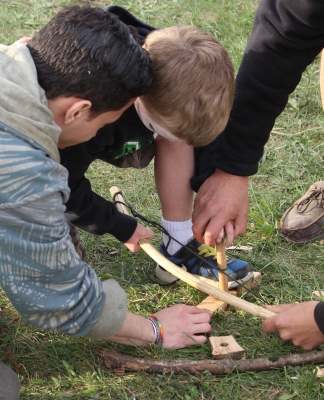 In other tents, these with closed, darkened flaps, someone standing near a flap holds the attention of a seated crowd in the darkened interior. No, not a cult gathering. Throughout each of the three fair days, workshops are offered in such diverse topics as “Farm-Raised Kids on an Organic Farm in Maine,” “Backyard Grain Growing,” “Advanced Seed Saving,” “Growing Grass-fed Vegetables,” and “Weedless Gardening.” (The last was one of the three workshops I held at the fair.)
In other tents, these with closed, darkened flaps, someone standing near a flap holds the attention of a seated crowd in the darkened interior. No, not a cult gathering. Throughout each of the three fair days, workshops are offered in such diverse topics as “Farm-Raised Kids on an Organic Farm in Maine,” “Backyard Grain Growing,” “Advanced Seed Saving,” “Growing Grass-fed Vegetables,” and “Weedless Gardening.” (The last was one of the three workshops I held at the fair.)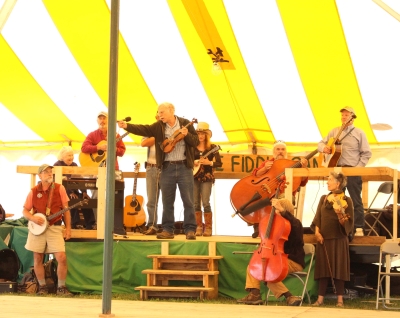
Old-Fashioned Fun
Common Ground Fair is “retro,” an improvement on country and county fairs, in doing less. No amplified voices of barkers try to woo you in to win a stuffed gorilla. In fact, a three-year-old boy trying to pound an oversize sledge hammer onto a pad as a test of strength, with a lot of help from his mom, was the only strength or skill test I saw — and no prizes offered.
No rides either. No fun? Given the happy whoops of the slew of children running up a grassy slope with flattened cardboard boxes, then jumping on them with a running start to slide down, I’s say they were having fun.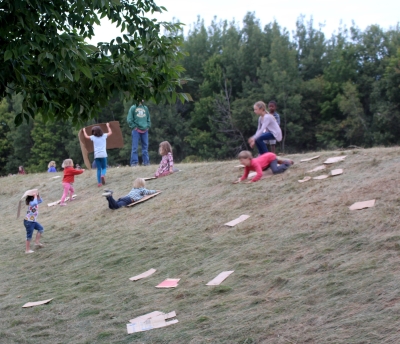
Just about everything at the fair is made or grown in Maine. (Used to be that everything had to be grown in Maine, which put coffee drinkers on edge. Maine-roasted coffee is now available at the fair.)
Twilight is wondrous at the fair, mostly because you can see the twilight. No strings of electric lights bring the fair to new life at the end of the day. Most people leave. The only light, besides the setting sun, is the soft, yellow glow of lanterns or campfires. The fragrance of the campfires and the sounds of campers’ home-grown music around the campfires are the parting senses as I leave the fair.
My Favorite Garden Designer
Beatrix Farrand is a name that most people do not recognize, although she was a woman who created some of the most beautiful landscapes and gardens in the world. And she did so at a time — in the early 20th century — when such professions were not open to women. Much of her landscape work was in Maine, on Mt. Desert Island, as was her home, Reef Point.
Reef Point was Beatrix’s family estate; under her care, it evolved into a horticultural heaven, with garden areas woven together by grassy paths. Spruce trees created microclimates that allowed azaleas and other plants not usually adapted to cold of Maine winters and the buffeting by ocean winds to survive and thrive. The gardens, the experimental plantings, and their descriptions in Farrand’s Reef Point Bulletins were all part of her vision of Reef Point as an educational enterprise.
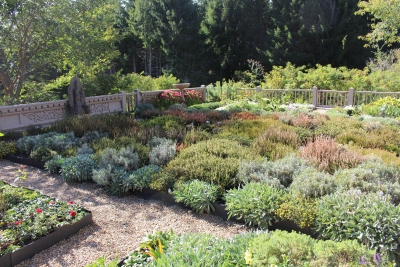 Alas, Reef Point Gardens did not fulfill the vision: wildfire and lack of funding forced Ms. Farrand to down-size. She dismantled Reef Point and moved to an addition she had built attached the home of Lewis and Amy Garland, the superintendent and chief horticulturalist of her Reef Point Estate.
Alas, Reef Point Gardens did not fulfill the vision: wildfire and lack of funding forced Ms. Farrand to down-size. She dismantled Reef Point and moved to an addition she had built attached the home of Lewis and Amy Garland, the superintendent and chief horticulturalist of her Reef Point Estate.
Garland Farm — my last stop on my visit to Maine — was Beatrix Farrand’s final design, incorporating many architectural elements and plants salvaged from Reef Point. In contrast to Ms. Farrand’s other projects, which included designs for Princeton University, Rockefellers’ Seal Harbor estate, The Mount (home of Edith Wharton, Beatrix’s aunt), Dumbarton Oaks (my favorite of all gardens), and the Santa Barbara Botanic Garden, Garland Farm is a small garden.
Looking out the French doors of Ms. Farrand’s study at Garland Farm onto the small parterre garden, your eyes are carried along a path to a Buddhist statue. Along that path are beds home to lavender, heathers, and other plants with year ‘round effect. The whole area is defined by a low balustrade, setting it off from the view of the meadow and grove of Norway spruce trees in the distance. This garden incorporates the same design principles — axis, year ‘round effect, structure, and integration of views — on an intimate scale, that were so successful in Beatrix Farrand’s larger projects.
SLOW SEED
/1 Comment/in Flowers, Planning, Vegetables/by Lee ReichAppreciated but not Touched
“Flower in the crannied wall, I pluck you out of the crannies, I hold you here, root and all, in my hand, Little flower . . . “ Whoa! Hold on there Lord Tennyson! Relax, little flower. I’m not doing any plucking.
I had hardly a hand in some of my best plantings, and that little flower is one of them.
There’s a small, moss-covered ledge at the base of the brick wall next to my front door, an east-facing spot that enjoys some morning sun in summer but shade from the nearby north wall the rest of the year. In short, it’s a perfect place for a summer vacation for my orchids, bonsai, and cyclamen.
The cyclamen is Cyclamen hederifolium, sometimes commonly called Persian violet (though a violet it is not; hence the need for botanical names). Although the flowers and leaves resemble those of the better known florist’s cyclamen (C. persicum), the two cyclamen species part company in some ways. Both the flowers and the leaves of Persian violet are much smaller than those of florist’s cyclamen, and the leaves of this diminutive species have decorative patterning. They resemble those of English ivy; hence the specific epithet “hederifolium.” Hedera is the botanical genus of English ivy. Flowers hover a few inches above the leaves on thin stalks, much like small, pink butterflies.
Best of all, Persian violet is cold-hardy where winter lows plummet as low as minus 20° F. Florist’s cyclamen must be grown as a houseplant.
Decades ago, I purchased seeds of Persian violet, and managed to raise a small stable of plants. They are ideal for naturalizing in partially shaded areas. While naturalizing the cyclamens seemed like a good idea, the dainty cyclamens would be gobbled up by the exuberant growth coaxed in the rich soil here. So my carefully nurtured cyclamens remained in their pots, wintering in a very cold spot in my basement and summering on that ledge near my front door.
Lo and behold, this year I’ve noticed two little plants that have seeded themselves in the bit of soil where the flagstone terrace butts up again the ledge. The effect is subtle, to say the least, but the flowers are all the more charming for their shyness. I can appreciate the second half of Lord Tennyson’s poem — “Little flower—but if I could understand, What you are, root and all, and all in all, I should know what God and man is” — but feel no need to, an aversion, in fact, to plucking the flower from its crannied wall.
Slow Cyclamen
Years ago, I learned three things about growing cyclamen from seed. Fresh seed is best. Keep the growing medium consistently cool and moist. Be patient; germination could take many weeks, and keep plants growing well for at least two years to allow the tuber to develop.
After that, plants can begin their spring dormancy, flowering and sprouting new leaves in late summer, the latter lasting well into winter, depending on temperatures.
Slow Ramps
Ramps (Allium tricoccum) are all the rage; here also, and my plan is to expand my ramp planting of two potted plants into a passel of ramps by growing them from seed. My experience in growing cyclamen from seed might come in handy here.
Although both plants enjoy similar growing condition, at least as far as the need for part shade in spring, the life cycle of ramps is different from cyclamens. Ramps sprout leaves in spring, send up a flower stalk, and then the leaves fade away as the plant goes dormant. The flowers talk remains, developing a head full of seeds — which I collected last week.
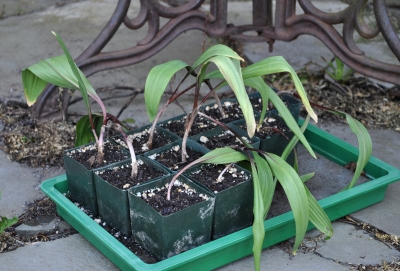 I planted the small seeds in potting soil in a flower pot. The journey begins. Those seeds could take anywhere from 6 to 18 months to sprout. When just ripe, ramp seeds have an under-developed embryo, a situation that inhibits germination. Keeping the seed warm and moist permits development of the embryo and, eventually, root growth.
I planted the small seeds in potting soil in a flower pot. The journey begins. Those seeds could take anywhere from 6 to 18 months to sprout. When just ripe, ramp seeds have an under-developed embryo, a situation that inhibits germination. Keeping the seed warm and moist permits development of the embryo and, eventually, root growth.
Once root dormancy has been broken, there’s still shoot dormancy to contend with. Shoots won’t grow until the seeds, with their root sprouts, have experienced a period of cool, moist conditions — that is, they recognize that winter is over and it’s safe to send a green shoot aboveground.
If root dormancy isn’t completed before winter sets in, it has to finish the following year, with shoot dormancy needing fulfilling after that: 18 months after sowing. Fulfilling root dormancy before winter allows shoot growth the following spring: 6 months after sowing. I’m making sure of root dormancy being fulfilled before cold weather sets in by keeping the pot of seeds moist and in the greenhouse. Temperatures are cool in the greenhouse in winter, so I’m expecting — hoping — for sprouts to appear by late winter.
Growing ramps and cyclamen from seed is similar in that a prime ingredient for success is patience. In the case of ramps, if everything goes right, I could be harvesting my first home grown ramps in 5 to 7 years.
SUCCESSES, EDIBLE AND OTHERWISE
/9 Comments/in Design, Flowers, Gardening, Vegetables/by Lee ReichStand Up Straight!
I am particularly proud of my Brussels sprouts this year — and I haven’t even tasted them yet. How odd that I should be proud of this vegetable that I spurned in the past, often quoting a friend who referred to them as “little green balls of death.” Then I put my own twist on that description, saying that perhaps the friend meant that Brussels sprouts were only palatable a “little boiled to death.”
I’ve come around, and decided, a couple of years ago, that Brussels sprouts were worth growing, despite their high demands on space and time. For good production in northern climates, the seeds need to be sown indoors in early March, and then harvest doesn’t start until October or sometime after the first frost. And for all that waiting, each plant — a mere single stalk with whorls of leaves from top to bottom and a sprout at the base of each leaf — takes up an area of about three feet by three feet.
Things would be bad enough if a Brussels sprouts plant just grew straight up to fill its allotted area. But the plant can’t support itself, so in its youth it flops down on the ground. Once that supine stem has created a firm base upon which to rise, the end of the growing stem curves more or less upward according to original plan. That youthful waywardness wastes and muddies lowermost sprouts, with the sprawling plant demanding even more space, which is a problem in an intensively-planted garden.
This summer, before the plants even had time to consider flopping down, I poked a bamboo pole into the ground next to each one, which I tied to the pole, adding ties to keep up with growth. Perhaps a bit too orderly for a vegetable garden, but my Brussels sprouts “trees,” each now over four feet tall, look quite attractive.
The “trees” are not likely to grow much higher because I pinched out the top bud of each plant in early September. This pinching redirects the plants energy from the highest growing point to the side shoots — which are the sprouts. All month, the sprouts have been fattening, soon to be snapped off and eaten.
Not Your Average Marigold
I also count among this season’s successes two little-known flowers, both of which elicited “oohs and ahhs” from visitors here. One of the flowers were Signet marigolds. You might think, marigolds?, they’re okay, but more “ho hum” than “ooh and ahh.” Not so.
Signet marigolds, Tagetes tenuifolia, are a different species from common marigolds, and they look a little different. Mostly, they’re smaller, expanding into amorphous mounds of fine, lacy, lime-green leaves, from which stare out small yellow or orange blossoms — most charming. A lemony-marigold aroma wafts from both the blossoms and the leaves.
Actually, the aroma can waft over the whole garden if you plant enough Signet marigolds — which I did this year. In the past, the seeds never germinated very well for me, so I just spot planted what few seedlings I could raise here and there in the garden.
 This spring, in mid-April, I sowed the seeds densely in an 8 by 6 inch seed flat. The dense planting led to an excessive number of crowded seedlings. While they were still young, I gently lifted each one to transplant into its own potting-soil-filled cell to grow for a month or so before planting out in the garden.
This spring, in mid-April, I sowed the seeds densely in an 8 by 6 inch seed flat. The dense planting led to an excessive number of crowded seedlings. While they were still young, I gently lifted each one to transplant into its own potting-soil-filled cell to grow for a month or so before planting out in the garden.
The few plants I poked in at the feet of vegetable beds on either side of the main path through the vegetable garden have grown into sprawling mounds that wash into the main and side paths of the vegetable garden like seawater into an undulating beach. The flowing mounds effectively soften any excessive orderliness of the garden — from the soldier-straight Brussels sprouts plants, for example.
A Cardinal in our Midst
My grape arbor creates a horizontal roof nine feet above my terrace. Each of the four grape vines rises to that height on a single trunk. What an opportunity for a climbing vine, especially one that climbs by twining! My other floral success this year has been with such a twining plant, cardinal climber (Ipomoea x multifida, a hybrid created by mating I. coccinea and I. quamoclit).
In the past, other species of Ipomoea climbed those trunks. Morning glory was one, but that only blooms, of course, in the morning. Moonflowers have also dressed up the trunks, but they bloom only at night.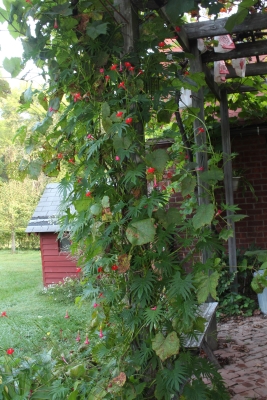
So this year, cardinal climber was the Impomoea species for the grape trunks. It blooms all day long, clothing itself in blossoms from top to bottom. The size and color of the blossoms, an inch or so across and cardinal red, seem best for relatively close viewing when sitting on the terrace.
No need for these flowers to soften any excessive orderliness of the arbor. The grape trunks wend their way skyward and their long, new shoots create plenty of disarray except right after they are pruned each spring.

